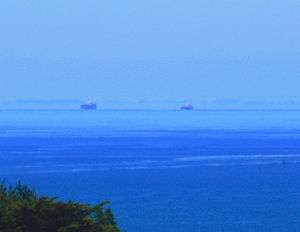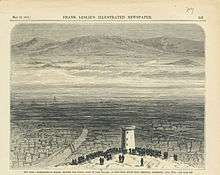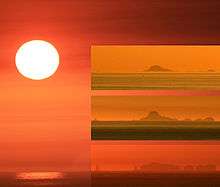Looming and similar refraction phenomena

While mirages are the best known atmospheric refraction phenomena, looming and similar refraction phenomena do not produce mirages. Mirages show an extra image or images of the miraged object, while looming, towering, stooping, and sinking do not. No inverted image is present in those phenomena either. Depending on atmospheric conditions, the objects can appear to be elevated or lowered, stretched or stooped. These phenomena can occur together, changing the appearance of different parts of the objects in different ways. Sometimes these phenomena can occur together with a true mirage.[1][2]
Looming

Looming is the most noticeable and most often observed of these phenomena. It is an abnormally large refraction of the object that increases the apparent elevation of the distant objects and sometimes allows an observer to see objects that are located below the horizon under normal conditions. One of the most famous looming observations was made by William Latham in 1798, who wrote:
I could very plainly see the cliffs on the opposite coast; which, at the nearest part, are between forty and fifty miles distant, and are not to be discerned, from that low situation, by the aid of the best glasses. They appeared to be only a few miles off, and seemed to extend for some leagues along the coast.[3]
Other famous observations that were called "mirages" may actually be referring to looming. One of those was described in Scientific American on August 25, 1894 as "a remarkable mirage seen by the citizens of Buffalo, New York".[4]
Looming is most commonly seen in the polar regions. Looming was sometimes responsible for the errors made by polar explorers; for example, Charles Wilkes charted the coast of Antarctica, where later only water was found.
The larger the size of the sphere (the planet where an observer is located) the less curved the horizon is. William Jackson Humphreys' calculations showed that an observer could see all the way around a planet nearly six times larger in radius than the Earth, with the same atmosphere as the Earth, because of looming.[5]
Sinking
Sinking is the opposite of looming. In sinking, objects that are normally seen above the horizon appear to be less elevated, or may even disappear below the horizon. While with looming the curvature of the rays is increasing, sinking produces the opposite effect.[6] In general looming is more noticeable than sinking because objects that get bigger stand out more than ones that get smaller.
Towering and stooping
Towering and stooping are more complex forms of atmospheric refraction than looming and sinking. While looming and sinking change the apparent elevation of an object, towering and stooping change the shape of the object itself. With towering, objects seem to be stretched; with stooping, objects appear shortened. The stretching and shortening of the objects are not symmetrical, and depends on the temperature profile of the atmosphere. The curvature of the rays changes more rapidly in some places because the temperature profile is curved.[2][6]
Image example and explanation

These images were taken from the same place on different days under different atmospheric conditions. The top frame shows looming. The island shape is not distorted, but is elevated. The middle frame shows looming with towering. The lowest frame is 5-image superior mirage of the islands. The uppermost image is stooped severely. As it is clearly seen from the image, the different refraction phenomena do not exclude each other, and may be present together, depending on atmospheric conditions.[2]
See also
References
- ↑ Heidorn, Keith (July 15, 1999). "The Superior Mirage: Seeing Beyond". The Weather Doctor. Retrieved April 23, 2010.
- 1 2 3 Young, Andrew. "Looming, Towering, Stooping, and Sinking". San Diego State University. Retrieved April 23, 2010.
- ↑ Latham, William (1798). "Account of a Singular Instance of Atmospherical Refraction". 88. The Royal Society: 357–360. ISSN 0261-0523. JSTOR 106981. OCLC 486168582.
- ↑ Miscellaneous notes and queries. 12. Manchester, New Hampshire: S. C. and L. M. Gould. 1894. p. 314. OCLC 448141550.
- ↑ Frazer, Calvin (August 1929). "Popular Mechanics". 52. Hearst Magazines. ISSN 0032-4558. OCLC 3643271.
- 1 2 Humphreys, William Jackson (1920). Physics of the air. J.B. Lippincott Company. p. 449. OCLC 569637.
External links
| Wikimedia Commons has media related to Mirage. |